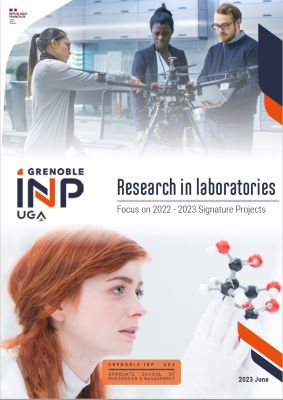For the past 18 months, the researchers at LGP2 and CEA Liten have been working together on a process to exploit the energy potential of lignin as part of the ENERLIG project.
During the manufacturing of cellulose*, lignin, which represents 25% of the biomass, is chemically extracted from the wood. This produces an aqueous solution known as black liquor, which is traditionally burnt in a recovery boiler to supply the plant with energy. “However, better energy efficiency can be obtained through an innovative process: the supercritical water gasification”, explained Dominique Lachenal, professor at Grenoble INP – Pagora and researcher at LGP2. This is the avenue being explored by scientists at LGP2 and CEA within the context of the Enerlig project, sponsored by Carnot Energies du Futur. The drawback of this process however is that it is not compatible with the sulphur compounds present in black liquor. “Therefore, the aim is to develop a process that combines the production of cellulose through sulphur-free cooking and recovers black liquor by gasification.” Supercritical water gasification is beneficial in that the water contained in the black liquor is used for the reaction itself, thereby avoiding a very high energy-consuming water evaporation stage.
Energy and chemical products
In addition, increasing the energy efficiency of the operation saves material that can be recovered otherwise, in particular in high added value chemical products. “Lignin is the only natural product that contains aromatic cycles. For instance, it will be possible to use it to produce phenols and to use the phenols to produce phenolic polymers that are currently obtained from petroleum.” Once it has completed the ENERLIG project, LGP2 intends to commit to new projects on this topic.
* Every year, 135 million tons of cellulose pulp are produced worldwide. 55 to 60% of the wood used is dissolved in the process waste, called black liquor.
During the manufacturing of cellulose*, lignin, which represents 25% of the biomass, is chemically extracted from the wood. This produces an aqueous solution known as black liquor, which is traditionally burnt in a recovery boiler to supply the plant with energy. “However, better energy efficiency can be obtained through an innovative process: the supercritical water gasification”, explained Dominique Lachenal, professor at Grenoble INP – Pagora and researcher at LGP2. This is the avenue being explored by scientists at LGP2 and CEA within the context of the Enerlig project, sponsored by Carnot Energies du Futur. The drawback of this process however is that it is not compatible with the sulphur compounds present in black liquor. “Therefore, the aim is to develop a process that combines the production of cellulose through sulphur-free cooking and recovers black liquor by gasification.” Supercritical water gasification is beneficial in that the water contained in the black liquor is used for the reaction itself, thereby avoiding a very high energy-consuming water evaporation stage.
Energy and chemical products
In addition, increasing the energy efficiency of the operation saves material that can be recovered otherwise, in particular in high added value chemical products. “Lignin is the only natural product that contains aromatic cycles. For instance, it will be possible to use it to produce phenols and to use the phenols to produce phenolic polymers that are currently obtained from petroleum.” Once it has completed the ENERLIG project, LGP2 intends to commit to new projects on this topic.
* Every year, 135 million tons of cellulose pulp are produced worldwide. 55 to 60% of the wood used is dissolved in the process waste, called black liquor.





